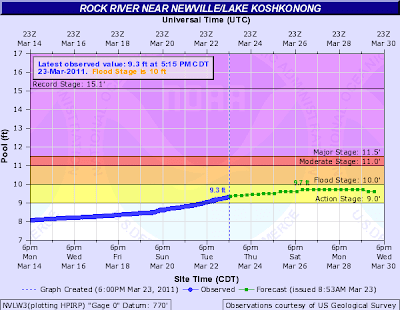From The Janesville Gazette 3.21.11
Jim Selin traveled north on Highway 26 outside Milton, when he couldn’t believe what he saw on a utility pole. High above the road, a bald eagle perched in full view of passing motorists.
Selin has admired bald eagles in Alaska and along the Wisconsin River near Sauk City, but he never saw one in Rock County until this winter.
“It’s really kind of cool,” the Edgerton man says.
"They are great birds.”
The raptors also made themselves at home at the south end of Rock County, where six bald eagles fed close to the dam in downtown Beloit much of the winter. In addition, they fished in open stretches of the Rock River in Janesville.
From Beloit to Janesville to Milton, our national symbol is making a noticeable comeback.
“We have more and more eagles in this area,” says Brian Buenzow, wildlife biologist with the state Department of Natural Resources. “It’s getting to the point where bald eagles are not that uncommon anymore.”
Buenzow works out of Newville office. He commonly sees bald eagles from Newville to the Indianford dam all winter. But the coming of spring does not mean the end to eagle sightings as birds migrate to their summer grounds.
At least one pair is nesting along the Rock River.
"In addition, at least two nesting pairs are on Lake Koshkonong,” Buenzow says. “I wouldn’t doubt it if there are more. When I’m out there fishing, there are almost always eagles flying around.”
Most of the southern Wisconsin nesting pairs have taken up residency in the last two to three years.
“The young are looking for suitable habitat, which is pushing them further south as the areas up north get more crowded,” says Richard Staffen, DNR Bureau of Endangered Resources, Madison. “They’re now showing up in even populated areas near Milwaukee. As far as we know, they are breeding in almost every county in the state.”
Eagles that plan to raise families in southern Wisconsin will begin courtship and nest building this month. They lay eggs and start incubation in April and begin hatching young in May. All are highly sensitive times, when people must take care not to get too close to the birds.
“During breeding season, you have to give them distance or they might abandon their nests,” Staffen says.
With bald eagles now thriving, it is easy to forget that Wisconsin came perilously close to losing them. In the early 1970s, the state had only 82 nesting pairs, and their numbers were in a free fall.
A big part of the eagle’s demise was the pesticide DDT, which caused the birds to lay soft-shelled eggs that would break before hatching. As a result, the bald eagle was put on the federal and state endangered species list. In 1971, Wisconsin banned the use of DDT, and the state set a recovery goal of 360 nesting pairs.
The birds have long since surpassed the number. Wisconsin now has about 1,150 pairs of nesting eagles.
The population is so healthy that the bird has been taken off federal and state endangered species lists. But it continues to be protected federally under the Bald and Golden Eagle Protection Act and The Migratory Bird Treaty Act.
In addition, wildlife officials say the bird needs human help to protect its dwindling nesting, roosting and feeding habitat so it will continue to thrive.
The DNR is in the middle of a five-year monitoring program to keep track of where eagles are and how their population is growing.
“We are learning more and more about eagles as time goes on,” Buenzow says.
“As wildlife managers, our job is to help populations like the bald eagle. They have made a great comeback.”
Buenzow ‘It’s getting to the point where bald eagles are not that uncommon anymore.’
Labels: Recreation











